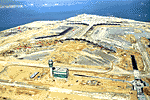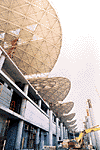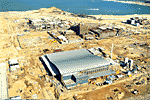|
NEW AIRPORT
Hong Kong's new airport at Chek Lap Kok opened in July 1998, after the island platform changed rapidly from a construction site to an operating facility.
LOCATION
 The new airport at Chek Lap Kok covering 1,248 hectares is almost four times the size of the old airport at Kai Tak. The "greenfield" site, adjacent to Lantau, was formed by levelling the tiny islands of Chek Lap Kok and Lam Chau and reclaiming land from the sea.
The new airport at Chek Lap Kok covering 1,248 hectares is almost four times the size of the old airport at Kai Tak. The "greenfield" site, adjacent to Lantau, was formed by levelling the tiny islands of Chek Lap Kok and Lam Chau and reclaiming land from the sea.
INITIAL CAPACITY
When the new airport opened, the first of its two 3,800 metre-long runways was in service. The new airport is able to operate round-the-clock without the night-time flight restrictions imposed at the old airport at Kai Tak.
The airport is able to handle 35 million passengers and three million tonnes of cargo annually compared with the 28 million passengers and 1.79 million tonnes of cargo that passed through Kai Tak in 1997.
The second runway will be completed by the end of 1998.
The airport will be developed in phases and ultimately is expected to handle 87 million passengers and nine million tonnes of cargo a year.
PASSENGER TERMINAL BUILDING
 Construction of what is Hong Kong's largest single building was a big job. Just over a kilometre long and covering an area of 550,000 square metres, Chek Lap Kok's passenger processing facility ranks as one of the largest international terminals in the world.
Construction of what is Hong Kong's largest single building was a big job. Just over a kilometre long and covering an area of 550,000 square metres, Chek Lap Kok's passenger processing facility ranks as one of the largest international terminals in the world.
The terminal building and concourse have been strategically positioned midway between the two parallel runways on the northeastern end of the airport island, with ferry services and other public facilities situated nearby.
The terminal has eight levels, three levels open to the public including arrivals and departures, a basement level housing support functions, such as the passenger shuttle train, baggage handling and mechanical and electrical equipment.
 The most recognisable feature of the terminal building is its unifying wing-like roof, symbolic of flight and movement. The shape of the roof, with its 45 degree slope, flows down in a noticeable wave from the east hall to its scalloped tail at the west end of the building.
The most recognisable feature of the terminal building is its unifying wing-like roof, symbolic of flight and movement. The shape of the roof, with its 45 degree slope, flows down in a noticeable wave from the east hall to its scalloped tail at the west end of the building.
The aesthetically pleasing design also acts as a heat barrier to make the roof more energy efficient and environmentally friendly than conventional designs.
The architectural "openness" of the vaulted ceilings and the soundproof and tinted glass walls in the terminal building allow passengers a panoramic view of the surrounding Lantau hills and the flight activities on the airfield from many points in the building.
PASSENGER CONVENIENCE
 The terminal building has been designed with passenger convenience and comfort in mind. Movement through the new airport is as simple and direct as possible with fast and convenient connections from processing facilities to the concourse via a passenger shuttle and moving walkways.
The terminal building has been designed with passenger convenience and comfort in mind. Movement through the new airport is as simple and direct as possible with fast and convenient connections from processing facilities to the concourse via a passenger shuttle and moving walkways.
A ground transportation centre, with direct walkways through to the terminal proper, houses the Airport Express railway station, operated by the MTR Corporation (MTRC). The line has been designed as an all-seated, business class-type service which carries passengers between the airport and Central district, with two intermediate stops at West Kowloon and Tsing Yi.
Inside the building, 2.5 kilometres of moving walkways runs throughout the terminal and the Y-shaped concourse for ease of movement. In addition, an Automated People Mover System, a fully automated driverless train, operates at the basement level along the full length of the 750 metre-long central concourse.
The design also takes into account the special needs of the disabled and provision has been made to accommodate people with walking difficulties, the wheel-chair bound, the blind and partially sighted and the deaf and hard of hearing.
A departing passenger is able to enter the building, check in, complete immigration formalities, and then board an aircraft all within half an hour.
And a shopping mall as well ...
Once past the immigration and security areas, passengers have a choice of either remaining in the large lounge overlooking the main concourse to wait for their flights or they can take an escalator down a level to the large shopping area known as the "Hong Kong Sky Mall".
About 30,000 square metres of space has been set aside for a wide range of shops, food and beverage outlets, banks and money changers.
|